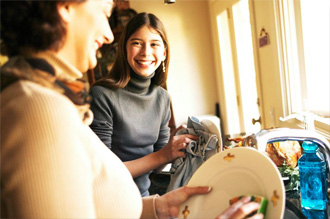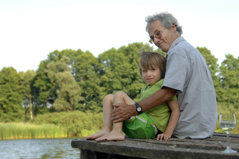
President Gordon B. Hinckley closed the April 2007 general conference by urging, “Parents, treat your children with great kindness.”
President Hinckley’s focus on kindness is typical of his gentle reminders to us. Years earlier, in his closing remarks of the April 2000 conference he said, “I hope that as fathers and mothers we will strive more fully to rear our children ‘in the nurture and admonition of the Lord,’ (Eph. 6:4), treating them with respect and love, giving encouragement at every opportunity and subduing our critical remarks.”
The best way to teach our children to be kind is to be kind ourselves. There are other ways to help our children learn kindness as well.
Simple, and Close to Home
As you consider ways to focus on kindness with your children, start with those close to you. Do simple, kind things for members of your family: help make a bed, put a loving note in a lunchbox, or smile. Kindness does not need to be grand.
Kindness doesn’t need to be unexpected, either. Feel free to plan kindness. Create opportunities for yourself or your family to exercise kindness. Maybe it’s time to get out the “pixie jar,” where everyone chooses a family member’s name for the week and is extra kind to that person.
Or maybe it’s time for a planned-in-advance family home evening service project. Planned kindness can be as rewarding as spontaneous kind acts.
“I remember the time I broke the ‘macaroni and cheese bowl.’ It was glass, and the perfect size for making a lot of different meals in, but we used it mostly for mac and cheese. I thought my mom would lose it when she found out. But she was so kind about it. She said, ‘That’s too bad. I know you didn’t mean to.’ And then she cleaned up the mess. I’ve never forgotten that."
More Difficult, and Anywhere
Don’t avoid the hard stuff. There is always that one person--someone at work or at church or your new in-law to whom it is hard to be kind. Make that person your special project, your Everest.
As you go through this exercise of kindness you’ll have experiences you can use in teaching your children. We parents are pretty good at saying, “Be nice to her!” and it’s a good exercise to try that on ourselves.
"No kind action ever stops with itself. One kind action leads to another. Good example is followed. A single act of kindness throws out roots in all directions, and the roots spring up and make new trees. The greatest work that kindness does to others is that it makes them kind themselves."
-Amelia Earhart
Teaching Kindness
Try these steps for teaching kindness:
- Awareness- Teaching children to notice the needs of others is the first step to being kind. Opportunities to be kind are all around. We can practice being aware in our own homes.
- Feelings or Empathy- Try to feel what the other person is feeling and decide to help. Point out times when you see someone who is in need and ask your children how they think this person is feeling.
- Action- Deciding to say something or do something that will help the person takes courage. Practice saying kind things to each other at home as practice to being kind to others rather than at school.
Planning to Teach
Anticipate your opportunity to teach kindness by filling in the following:
Create the need for kindness by telling a story of a kind act.
Establish what your child will learn and why this is important by saying “Kindness helps us feel happy because we are helping someone else feel happy.”
Model kindness by role playing a kind statement or act. (“I can be more kind by. . .)
Talk about how to be more aware of opportunities to be kind. (e.g., an example with sharing toys or not pushing or hitting)
Give positive feedback by noticing the kind things family members do and telling them how it makes you feel when you see them acting in kind ways.
Mantra
The Family Home Evening Book suggests that parents encourage their children to look in a mirror and say such things as, “I am a child of God. I can learn and grow. I can be kind to others.” Iterations like these have been shown to be powerful predictors of behavior.
Pixies and Practice
Practice kindness. Consider having a jar with every family member’s name in it. Have everyone pick a name out of the jar. Then be that person’s pixie--do something kind for them during the week.
Journal
Start a special family scrapbook that has only pages about kindnesses done by your family. Your kids will work hard to get their own pages in it. www.helpothers.org
Karma
Remember Karma. Kindness is its own reward. Expect no positive reaction or recognition for your kindness and remain un-offended when none is forthcoming. Explain to your children that sometimes kindness is recognized by others, but other times it’s only recognized by our Heavenly Father.
Quote
Gather favorite quotations on kindness and put them on the mirror or the fridge. Change them from time to time to keep you and your children inspired and excited to focus on kindness.
Kindness Day
Pick a day where you do acts of kindness to no one in particular – pick up trash, plant a tree, clean up graffiti, park in the back of the lot to leave spaces in the front, leave an inspirational book with your anonymous inscription in a public place. www.helpothers.org

Harold Kushner, the best-selling author of When Bad Things Happen to Good People, said, “When you carry out acts of kindness you get a wonderful feeling inside. It is as though something inside your body responds and says, yes, this is how I ought to feel.”
"Constant kindness can accomplish much. As the sun makes ice melt, kindness causes misunderstanding, mistrust and hostility to evaporate." Says Albert Schweitzer
We help our children have that content feeling as we teach them to focus on kindness.
Sources
Hinckley, Gordon B. “A Time of New Beginnings.” Ensign. May 2000: 87.
----- “Closing Remarks.” Ensign. May 2007:105.
McLaughlin, Mignon, The Second Neurotic’s Notebook, 1966.